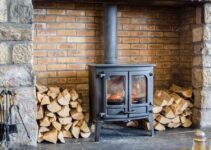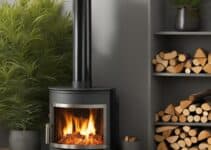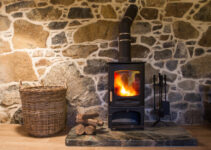Log burners are a great addition to the home, both for practical and aesthetic reasons. But when it comes to fuelling them, things can get surprisingly complicated.
Along with choosing the right wood and seasoning it properly, we must also consider storage.
And that’s exactly what we’ll look at in this article. Below, you’ll learn everything you need to know about storing firewood, including indoor and outdoor conditions and what to do about rain.
Where Should I Store My Firewood in the Winter?
The best place to store your firewood in the winter is outdoors, ideally under a cover. Exposure to rain and snow isn’t the end of the world but will cause your firewood to degrade more quickly.
However, a permanent cover should be your first option rather than a tarp or similar temporary solution.
This is because firewood needs as much airflow as possible to keep it dry. Covering it with a tarp obviously keeps the rain off, but it can also restrict airflow.
If this happens and your firewood gets wet, it’s more likely to get mouldy and break down. A permanent structure (or firewood shed) is a better compromise between coverage and airflow.
You may already know this, but it’s best to only bring small amounts of firewood indoors at one time.
This is mainly to minimise the chance of bringing pests into your home, but it also helps to keep the firewood at the best moisture level.
If you bring it indoors and store it near the fire, it could dry out too much.
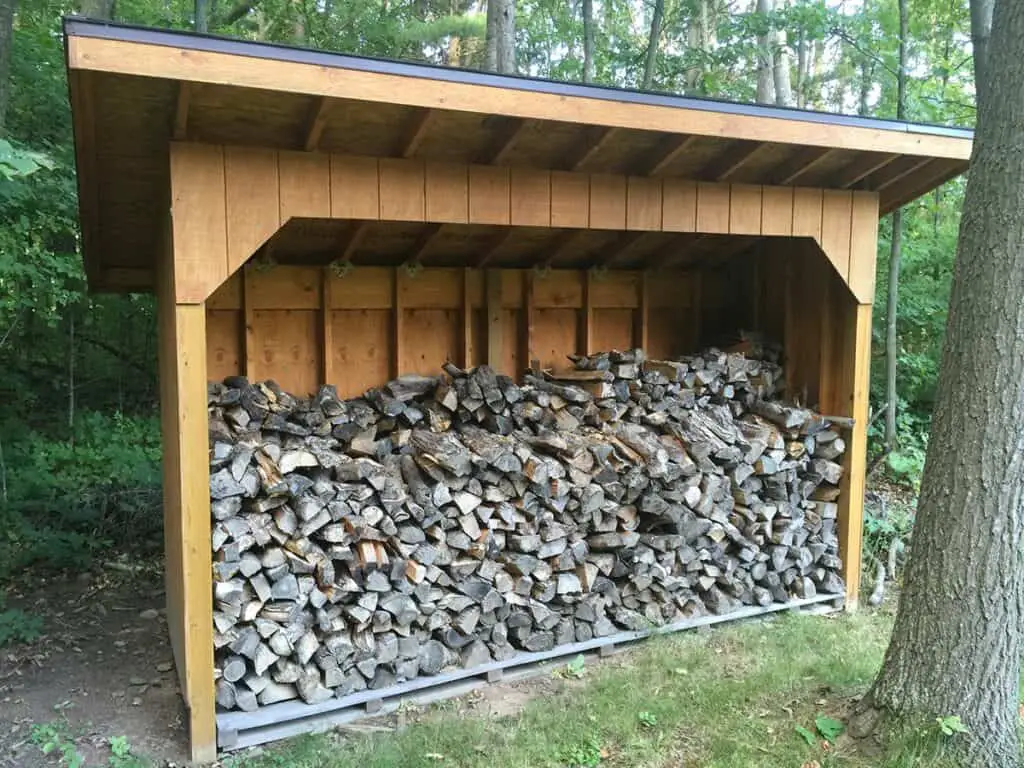
However, it’s not the end of the world if this happens. If you only ever have a small amount of firewood at one time, by all means keep it indoors if it’s easier.
Outdoors is best for large amounts of firewood, simply because you’ll have more space to store it.
How to Store Firewood Outside in Winter
Storing firewood outside in winter isn’t too difficult. That said, you’ll want to prep your storage area before adding the wood in order to keep it dry.
Below are some brief tips on how to store your firewood outside in the winter:
·!– /wp:paragraph –>
· Build a raised platform to keep the firewood off the ground. If this isn’t possible, stack it on a tarp or other waterproof material. You’ll want something to create a barrier between your firewood and ground moisture.
· Stack logs on top of each other, all facing the same direction. This is to ensure there’s decent airflow through the pile (and it makes stacking easier).
· If possible, build a physical shelter over your storage area. A simple frame with some corrugated plastic on it will do the job.
· You should try to avoid storing firewood in a wooden shed. Firewood can carry woodworm or similar pests, which could damage your shed. While the chances are low, it’s best to avoid them altogether.
· Airflow is the most important factor to consider. If you get it right, it won’t even matter too much if your firewood gets wet.
If you stack the firewood correctly, and use it fast enough, you won’t have any problems with rot. It’s not a massive deal if some do rot, as you can just remove them.
Rotted wood will still burn, but it’s not the most pleasant fuel source to use in your log burner.
How Long Can You Store Firewood Outside?
In theory, you can store firewood outside until it’s rotted away to dust. In practice, though, firewood is best within 3 years of it being seasoned.
It doesn’t necessarily become less flammable, but it starts to break down and/or rot.
This is why you season your firewood. Seasoning involves removing moisture, and once it reaches the correct level (less than 20% moisture), wood can be stored for a long time without it rotting.
Keeping it outside will affect this, as even if it’s out of the rain, you can expect ambient moisture to have some effect.
The bottom line is that if you use your log burner in the winter and you don’t get through your wood store, you’re buying too much.
When the next season rolls around, buy a smaller load and stack the old wood on top. Doing so ensures you use it first, and hopefully you won’t have any left over at the end of the season.
As mentioned, the most important metric when storing firewood is moisture control.
This is best done with airflow. So, provided there’s decent circulation around your log pile, it should easily last for 3 years or more.
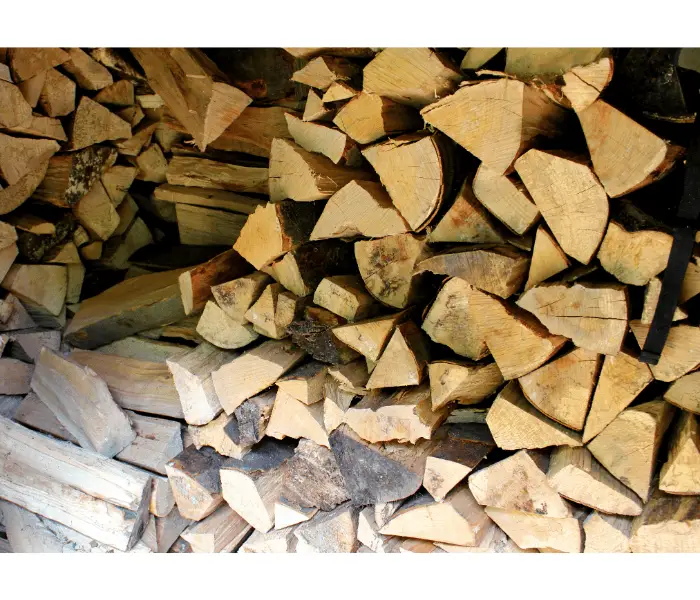
Can Firewood Get Rained On?
The short answer is that firewood absolutely can get rained on. You’ll want to let it dry out before you burn it, though, as damp wood will create a lot of smoke.
There shouldn’t be any issues with your firewood getting rained on once or twice, but you should aim to store it somewhere dry.
The bigger issue is wood that constantly gets wet and then dries. It can start to rot if this happens, and you can probably expect some mould and fungal growth.
These shouldn’t have an impact on the burning process, but disturbing wood could release spores, which isn’t great for your health.
You’ll want to avoid your wood getting wet as much as possible, both during and after seasoning. Getting wet during seasoning delays the process, meaning it won’t be ready as quickly.
Firewood getting wet during storage can increase the chances of rot, which can lead to wasted fuel.
Of course, if your wood does get rained on, you won’t need to do much.
Provided it’s kept out of further rain, it’ll dry off on its own. Just try to avoid it constantly getting wet, as this is a more difficult problem to solve.
Should You Cover Firewood with a Tarp?
Covering firewood with a tarp is fine if you don’t have any other options, but it generally should only be a last resort.
If you must use a tarp, only cover the very top of your firewood pile, leaving the sides exposed. It’s far better to keep your wood under a permanent cover that has space between it and the wood pile.
You can probably guess by now why a tarp isn’t a great option: airflow. Tarps are waterproof and, by extension, are pretty windproof. While this is ideal for many uses, it doesn’t help with storing firewood.
Covering firewood with a tarp can lead to the following issues:
· Trapping moisture, whether this is from the ground or the wood itself. Even the best covered log pile will have some moisture get in there. But if it’s covered with a tarp, it won’t be able to evaporate properly.
· Reduces airflow because tarp is impermeable, meaning air can’t circulate properly around the wood pile.
· Speeding up rot and decay. The above problems cause rot to speed up, especially as a tarp can raise the temperature of the wood pile if it’s exposed to sun.
So, the bottom line is that you should try to avoid using a tarp on your firewood pile. If it’s the only option you’ve got, drape it across the top and tie it down.
This at least means air can flow through the sides of the pile to reduce the chances of mould growing.
How Do You Store Firewood so It Doesn’t Rot?
To store firewood so it doesn’t rot, you need to ensure it’s kept away from moisture and that there’s good air circulation.
There’s really not much more to it than that, as seasoned wood has a low enough moisture content that it shouldn’t degrade on its own otherwise.
If you’re storing it indoors, such as in a shed or garage, make sure the airflow is as good as possible. You can do this by opening a window at the very least.
Ideally, there should be 2 openings (such as 2 windows or a window and a door) to create a draft through the storage area.
While this isn’t always possible, you’ll need something to prevent the air from getting stagnant. If you can’t leave a window open all the time, open and close it for a few hours a day to let in some fresh air.
Also, you’ll want to store your firewood bark-side down.
This allows any residual moisture to more easily evaporate from the wood, although properly seasoned wood should be done losing moisture.
You can still stack it close together when building your log pile. In fact, this is preferred to prevent it from collapsing as you remove logs. Even tightly-packed logs will have small gaps between them, which will be enough air circulation if there’s a breeze in the storage area.
So, to recap, the best way to store firewood so it doesn’t rot is:
· Under cover. There should be a gap between the structure’s roof and the log pile.
· Stacked bark-side down. This is to ensure any remaining moisture can evaporate.
· Packed tightly. Your log pile should be well stacked to stop it from falling over.
· Elevated off the ground. At the very least, stack your logs on a tarp. A concrete platform or wooden planks are better options, though.
Storing your firewood in this way will keep it fresh for as long as possible with minimal involvement from you once it’s stacked.
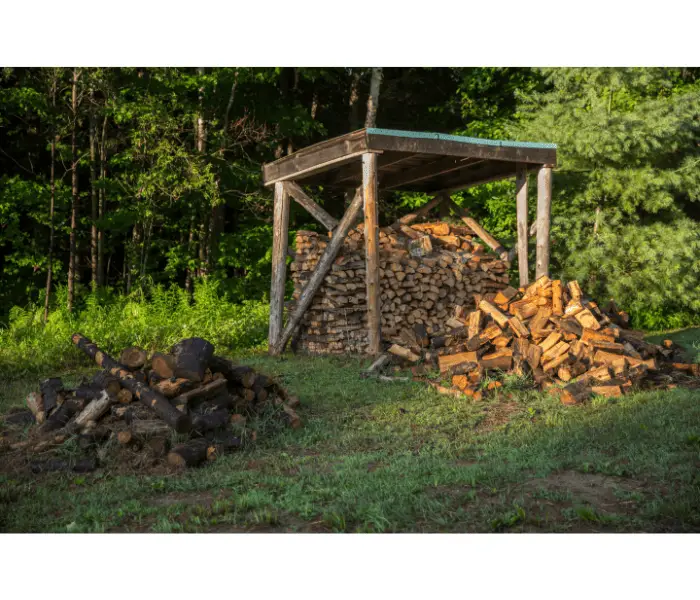
Storing Firewood in Garage
A garage is an appropriate place for storing firewood, provided you’ve prepped the area and the logs beforehand.
This is because a garage is more of an indoor space than, say, a shed, so you should treat it more like storing your logs inside than outside.
A few useful tips for storing your logs in your garage include:
Make Sure it’s Seasoned
This is a no-brainer, but make sure your firewood is properly dry before bringing it into your garage. It’s likely that the airflow will be worse in a garage than a shed, as they’re usually more weather-resistant.
As a result, wet wood is more likely to rot.
So, at the very least, make sure you only buy seasoned wood. If you’ve cut it yourself, season it outdoors as normal before storing it in your garage. Treat your garage the same as storing firewood in your living room.
Check for Bugs
If possible, check your firewood for bugs before bringing it into your garage. This is for the same reason as the one given above: you should treat it as more of an indoor space.
The last thing you’ll want to do is bring potentially destructive bugs into your home.
Sure, the odd woodlouse won’t be an issue, but you’ll want to look out for woodworms, beetles and other similar bugs. The chances of finding them in firewood are low, but you can never be too careful.
Stack Away from Walls (and Fire Hazards)
Build your log stack away from external walls, as this can reduce airflow and increase moisture build-up. As mentioned, these are both big no-nos when it comes to storing firewood for a season.
Unsurprisingly, you should also keep your stack of firewood away from fire hazards.
Avoid keeping the pile within 2 metres of anything from a tumble dryer to petrol lawnmowers and oils, wood stains, etc. Although it won’t completely remove the chance of a fire, it’ll certainly reduce the potential.
Keep the Area Tidy
Make sure you regularly sweep up twigs and loose bark from your firewood storage area. These can create ideal breeding grounds for bugs, or serve as effective kindling for a potential fire.
How Do You Store Firewood Indoors UK?
Storing firewood indoors in the UK is easy. Simply stack the logs with sufficient airflow in your chosen location, whether this is a garage or a small stack in the room that contains your log burner.
However, you should aim to keep your stack of fuel 2 metres or so from the actual log burner. While it’s unlikely any sparks will escape, the last thing you want is to create a fire hazard. Treat your log pile the same as rules regarding combustible materials near log burners.
Where is the Best Place to Store Firewood?
Objectively, the best place to store firewood is outdoors under cover, such as in an outbuilding or in a custom-build storage area.
Outdoor storage areas will generally have better air circulation than indoor ones, which is vital for preserving wood.
The other main benefit to storing wood outdoors is that you can usually fit more of it in a storage area. After all, not many people will have room in their homes for a season’s worth of firewood!
Ideally, you’ll want a covered storage shelter that receives plenty of sunlight and a nice breeze. This covers all the important factors for keeping your firewood in good condition.
But if this isn’t possible, choose a shed with a window so you can create decent air circulation through it.
Final Thoughts
And there you have it: everything you need to know about storing firewood for log burners. Provided you know the basics, it’s really not a difficult thing to do.
Choosing an appropriate storage location might take a bit of work, but it’s worth it when you see the difference it makes compared to a bad storage area!
The bottom line is that properly storing firewood pays off in the long run. So, put the effort in and you’ll thank yourself in the future.
